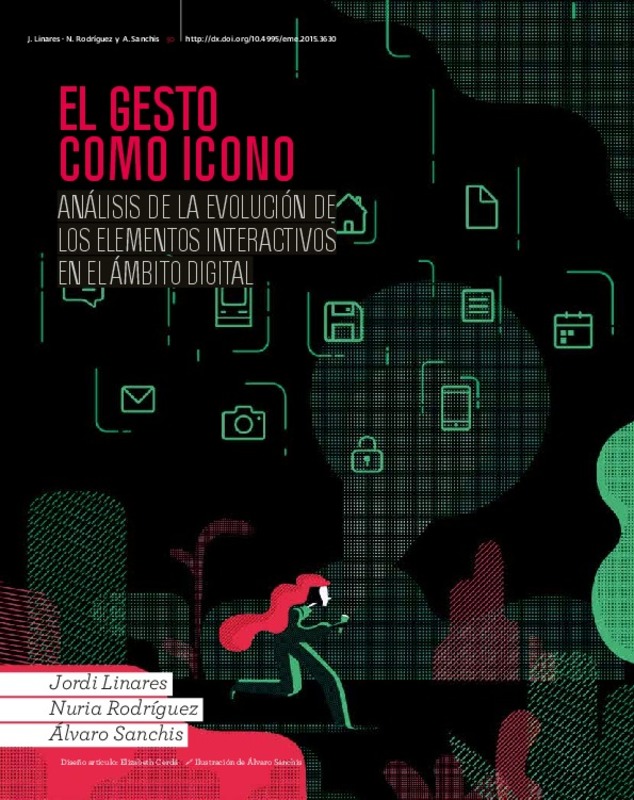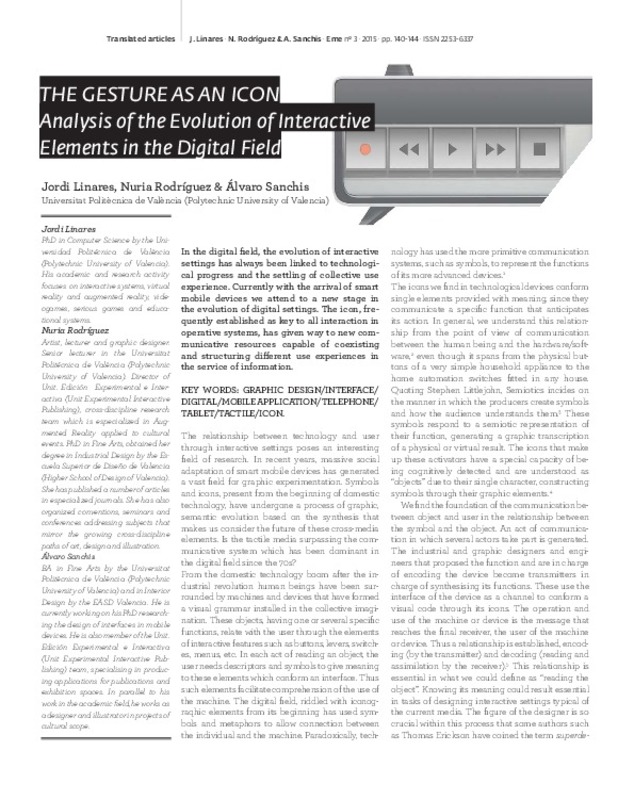JavaScript is disabled for your browser. Some features of this site may not work without it.
Buscar en RiuNet
Listar
Mi cuenta
Estadísticas
Ayuda RiuNet
Admin. UPV
El gesto como icono: Análisis de la evolución de los elementos interactivos en el ámbito digital
Mostrar el registro sencillo del ítem
Ficheros en el ítem
| dc.contributor.author | Linares Pellicer, Jordi
|
es_ES |
| dc.contributor.author | Rodríguez Calatayud, Nuria
|
es_ES |
| dc.contributor.author | Sanchis Gandía, Álvaro
|
es_ES |
| dc.date.accessioned | 2017-01-13T08:40:17Z | |
| dc.date.available | 2017-01-13T08:40:17Z | |
| dc.date.issued | 2015-04-30 | |
| dc.identifier.issn | 2253-6337 | |
| dc.identifier.uri | http://hdl.handle.net/10251/76735 | |
| dc.description.abstract | [EN] In the digital field, the evolution of interactive settings has always been linked to technologi-cal progress and the settling of collective use experience. Currently with the arrival of smart mobile devices we attend to a new stage in the evolution of digital settings. The icon, fre-quently established as key to all interaction in operative systems, has given way to new com-municative resources capable of coexisting and structuring different use experiences in the service of information. | es_ES |
| dc.description.abstract | [ES] En el ámbito digital, la evolución de los entornos interactivos ha estado siempre vinculada a los progresos tecnológicos y al asentamiento de la experiencia de uso colectiva. En la actualidad, tras la llegada de los dispositivos móviles inteligentes, asistimos a una nueva etapa en la evolución de los entornos digitales. El icono, frecuentemente establecido como la clave de toda interacción en los sistemas operativos, está dejando paso a nuevos recursos comunicativos capaces de convivir y estructurar experiencias de uso distintas al servicio de la información | es_ES |
| dc.language | Español | es_ES |
| dc.language | Inglés | es_ES |
| dc.publisher | Universitat Politècnica de València | |
| dc.relation.ispartof | EME Experimental Illustration, Art & Design | |
| dc.rights | Reconocimiento - No comercial (by-nc) | es_ES |
| dc.subject | Graphic design | es_ES |
| dc.subject | Interface | es_ES |
| dc.subject | Mobile Application | es_ES |
| dc.subject | Telephone | es_ES |
| dc.subject | Tablet | es_ES |
| dc.subject | Tactile | es_ES |
| dc.subject | Icon | es_ES |
| dc.subject | Diseño gráfico | es_ES |
| dc.subject | Interfaz | es_ES |
| dc.subject | Digital | es_ES |
| dc.subject | Aplicación móvil | es_ES |
| dc.subject | Icono | es_ES |
| dc.title | El gesto como icono: Análisis de la evolución de los elementos interactivos en el ámbito digital | es_ES |
| dc.title.alternative | THE GESTURE AS AN ICON: Analysis of the Evolution of Interactive Elements in the Digital Field | es_ES |
| dc.type | Artículo | es_ES |
| dc.date.updated | 2017-01-12T13:36:12Z | |
| dc.identifier.doi | 10.4995/eme.2015.3630 | |
| dc.rights.accessRights | Abierto | es_ES |
| dc.contributor.affiliation | Universitat Politècnica de València. Departamento de Pintura - Departament de Pintura | es_ES |
| dc.contributor.affiliation | Universitat Politècnica de València. Centro de Investigación Arte y Entorno - Centre d'Investigació Art i Entorn | es_ES |
| dc.contributor.affiliation | Universitat Politècnica de València. Facultad de Bellas Artes - Facultat de Belles Arts | es_ES |
| dc.description.bibliographicCitation | Linares Pellicer, J.; Rodríguez Calatayud, N.; Sanchis Gandía, Á. (2015). El gesto como icono: Análisis de la evolución de los elementos interactivos en el ámbito digital. EME Experimental Illustration, Art & Design. (3):50-61. https://doi.org/10.4995/eme.2015.3630 | es_ES |
| dc.description.accrualMethod | SWORD | es_ES |
| dc.relation.publisherversion | https://doi.org/10.4995/eme.2015.3630 | es_ES |
| dc.description.upvformatpinicio | 50 | es_ES |
| dc.description.upvformatpfin | 61 | es_ES |
| dc.type.version | info:eu-repo/semantics/publishedVersion | es_ES |
| dc.description.issue | 3 | |
| dc.identifier.eissn | 2341-3018 | |
| dc.description.references | Erickson, THOMAS: The Art of Human Computer Interface Design, Massachussets, Addison-Wesley, 1990. | es_ES |
| dc.description.references | Maltese, CORRADO: Semiología del mensaje objetual, Madrid, Alberto Corazón, 1972. p. 166. | es_ES |
| dc.description.references | NIELSEN, JAKO B Y BUDIU, RALUCA: Usabilidad en dispositivos móviles, Madrid, Ediciones Anaya Multimedia, 2013. p. 75. | es_ES |
| dc.description.references | Norman, DONALD: Dise-o emocional. Por qué nos gustan o no los objetos cotidianos, Madrid, Paidós Transiciones, 2005. | es_ES |
| dc.description.references | Sebeok, THOMAS: Signos: una introducción a la semiótica, Madrid, Paidos, 1996. p. 25. | es_ES |
| dc.description.references | SHNEIDERMAN, BEN Y PLAISANT, CATHERINE: Dise-o de interfaces de usuario, estrategias para una interacción persona-computadora efectiva, Washington, Pearson Educación, 2005, p. 17. | es_ES |
| dc.description.references | Stephenson, NEAL: En el principio, fue la línea de comandos. En Mapas. Madrid, Traficantes de sue-os, 2003. p. 24. | es_ES |









